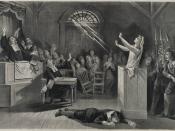Salem's Hysteria Revealed
During the winter of 1692, the small village of Salem, Massachusetts, was unaware of the coming events. Powered by paranoia and fear, a wave of witch hysteria swept through the quiet Salem village. Fueled by fanaticism, religious intolerance, and many other factors, the infamous Salem Witch Trials resulted.
Salem Village, also known as the "farmers", was a relatively small farming community with a population just over 500. The Salem Village was smaller than the Salem Town, which was approximately eight miles away. Salem Town was mainly used as a large port, and was a very prosperous fishing community (Kallen 14).
In Salem, the Puritan religion dominated. In order to worship God freely, the Puritans came to America. "They encouraged direct personal religious experience, strict moral conduct and simple worship services."(Kallen 17). However, the Puritans did not accept any other kind of religious practice and showed little pity towards others in the community.
It was said that a person's misfortune was "ordered by god"(Linde 28). The Puritans held a strict code, which allowed sinners to be punished severely. The punishments that were set in were often meant to embarrass and cause pain upon the "sinners"(Kallen 18).
In early years of America, the people were unaware of certain things. Sickness, for instance, was an important issue, for people back then didn't know how to manage and cure such complex illnesses. The Puritans didn't have much information about subjects such as these, so they often came to believe that unexplainable events were being performed by a powerful source of evil thus bringing about witchery. In the eyes of the Puritans, the believed that they must eliminate those who threatened their beliefs, including witches (Sutter). " To the Puritans, witches, demons, and evil spirits were as real as the rocky...


